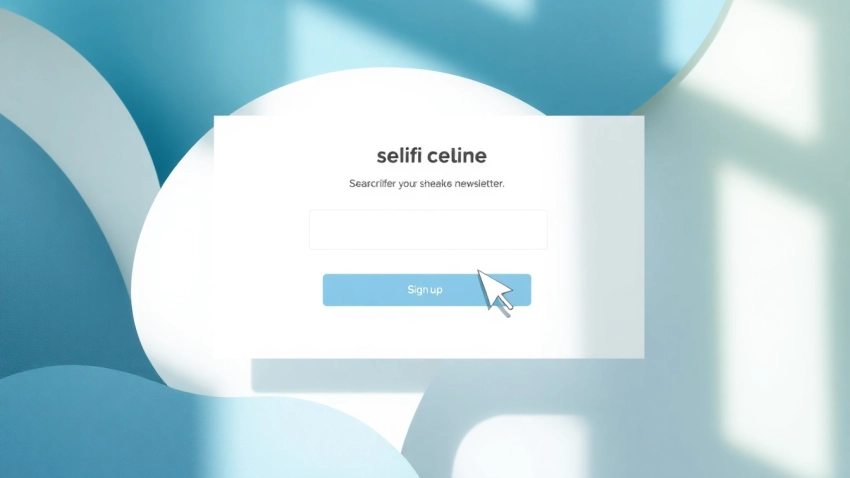
Effective Strategies for Boosting Your Newsletter Signup Engagement
Understanding the Importance of Newsletter Signup
In today’s fast-paced digital landscape, building a direct line of communication with your audience is more crucial than ever. One of the most effective ways to achieve this is through a newsletter signup. This strategy not only helps brands keep their customers informed but also enhances engagement and loyalty. In this article, we’ll delve deep into the significance of newsletter signups, best practices for form optimization, common challenges, successful examples, and how to measure the effectiveness of your signup strategy.
Why Newsletter Signup Matters for Brands
Newsletter signups serve as a bridge between brands and their audiences. When customers opt for your newsletter, they genuinely express interest in your content, products, or services. This engagement allows brands to:
- Build Relationships: Regular communication fosters trust, making customers feel valued and informed.
- Targeted Marketing: By knowing the preferences of subscribers, companies can tailor their content and offers, leading to higher conversion rates.
- Cost Efficiency: Email marketing typically has a higher ROI compared to other digital marketing strategies.
The Role of Email Marketing in Customer Retention
With competition in every industry soaring, retaining customers has become as critical as acquiring them. Email marketing, facilitated through newsletter signups, plays a substantial role in this retention strategy. Here are a few insights into its effectiveness:
- Personalized Content: Brands can use customer data to send personalized content that resonates with individual preferences, driving repeat engagement.
- Feedback Channels: Newsletters can incorporate feedback forms or surveys, allowing brands to continually adapt and improve their offerings based on subscriber input.
- Exclusive Offers: Subscribers can be rewarded with exclusive discounts or early access to new products, which not only drives sales but reinforces loyalty.
Benefits of a Well-Designed Newsletter Signup
A thoughtfully designed newsletter signup form can significantly increase subscriber numbers. Below are several benefits of implementing such a form:
- Enhanced Visibility: An effective signup form is easy to find and use, reducing barriers for potential subscribers.
- Improved User Experience: A well-structured form can provide an engaging experience that encourages signups rather than deterring them.
- Measurable Results: Properly integrated signup forms allow for tracking performance metrics, making it easy to assess the success of your strategies.
Best Practices for Optimizing Newsletter Signup Forms
Key Elements of High-Converting Newsletter Signup
Ensuring your newsletter signup form converts effectively hinges on several key elements:
- Clear Call-to-Action (CTA): Use actionable and persuasive language to urge users to sign up. Phrases like “Join Our Community” or “Get Exclusive Content” can motivate visitors.
- Minimal Fields: Limit the number of fields to capture essential information, like name and email, to avoid overwhelming users.
- Incentives: Offering incentives such as discounts, downloadable resources, or exclusive content can dramatically increase signup rates.
Placement Strategies for Visibility
The visibility of your newsletter signup form is crucial for maximizing engagement. Here are strategies that can enhance its placement:
- Above the Fold: Place the signup form prominently on your homepage or landing pages, ensuring it’s visible without scrolling.
- Exit-Intent Popups: Utilize exit-intent technology to present a signup form just as a user intends to leave your page, capturing potentially lost leads.
- Dedicated Landing Page: Create a specific landing page for your newsletter signup, which can be promoted across various channels, directing traffic effectively.
Design Tips to Enhance Usability
Design plays a crucial role in the usability of your newsletter signup form. Consider the following design tips:
- Responsive Design: Ensure your forms are mobile-friendly to cater to users on smartphones and tablets.
- Visual Appeal: Use contrasting colors, readable fonts, and engaging images to draw attention to the form.
- Clear Instructions: Provide straightforward instructions or examples of what subscribers can expect upon signing up.
Common Challenges in Newsletter Signup Implementation
Overcoming User Reluctance to Subscribe
User reluctance to subscribe can stem from various concerns, including fear of spam or lack of interest in content. To combat this:
- Transparency: Clearly state how often subscribers will receive emails and what kind of content they can expect.
- Privacy Assurance: Highlight your commitment to protecting user information, potentially even linking to your privacy policy for reassurance.
- Social Proof: Incorporate testimonials or subscriber counts to demonstrate the value others see in your content.
Addressing Privacy and Spam Concerns
With growing concerns regarding online privacy, brands must adopt strategies to alleviate these fears:
- Clear Privacy Policy: Provide a brief overview of your privacy policy directly on the signup form, ensuring users know their data is safe.
- Double Opt-In: Implement a double opt-in process that requires users to confirm their subscription via email, reducing spam complaints.
- Unsubscribe Option: Always include an easy-to-find unsubscribe link in your newsletters, demonstrating respect for user preferences.
Managing Subscriber Expectations Effectively
Setting the right expectations for what subscribers will receive is key to maintaining engagement:
- Welcome Email: Send a warm welcome email post-signup that outlines the benefits and content users can expect.
- Consistency: Develop and stick to a consistent schedule for sending newsletters so subscribers know when to anticipate new content.
- Engagement: Encourage feedback on content preferences and adapt your newsletters accordingly to better serve your audience.
Examples of Successful Newsletter Signup Pages
Inspiring Designs from Various Industries
Examining successful newsletter signup pages can provide valuable insights into effective design and content strategies. Here are some examples of elements that work well:
- Bold CTAs: Successful pages often feature clear, bold calls to action that encourage visitors to sign up instantly.
- Visual Elements: Engaging visuals, such as infographics or illustrations, can enhance the appeal of signup forms.
- User-Friendly Formats: Simplicity in format captures visitor attention and minimizes drop-off during the signup process.
Analyzing What Works in Newsletter Signup
Key analysis of effective strategies can help brands refine their approach:
- Split Testing: Many successful brands utilize A/B testing to discover which specific elements, like color or wording, yield higher conversion rates.
- Data Tracking: Implementing analytics tools allows brands to see where users are coming from and how they interact with signup forms.
- Iterative Improvements: Continuous improvement is pivotal; brands must be willing to adapt based on what performance data reveals.
Learning from Top-Performing Signup Pages
By regularly reviewing high-performing signup pages, brands can identify current trends and preferences, ensuring their approach remains relevant and engaging. Key lessons include:
- User-Centric Design: Top examples prioritize user experience, ensuring easy navigation and form completion.
- Tangible Benefits: Highlighting the specific benefits of subscribing directly correlates with higher engagement rates.
- High-Quality Content: Brands that offer valuable, insightful content are more likely to see a higher signup rate.
Measuring Success of Your Newsletter Signup Strategy
Key Metrics to Track for Optimization
Monitoring the performance of your newsletter signup strategy is vital for ongoing success. Key metrics to track include:
- Conversion Rate: The percentage of visitors who complete the signup process is a direct measure of your form’s effectiveness.
- Churn Rate: Understanding how many subscribers opt out or unsubscribe can help identify areas for improvement in content or engagement.
- Open and Click-Through Rates: These metrics inform you about the engagement level of your existing subscribers, helping to gauge overall content value.
Using A/B Testing to Improve Signup Rates
A/B testing is an invaluable tool for optimizing newsletter signup forms. By comparing two versions of a form, brands can learn which design or copy resonates better with their audience. Here are some elements to test:
- Text Variations: Different CTAs can dramatically impact conversion rates, so testing various phrasings can yield insights.
- Form Length: Experimenting with the number of fields (asking for name vs. just email) can help determine the ideal length that minimizes user drop-off.
- Visual Appeal: Testing different layouts or color palettes helps in emphasizing or de-emphasizing elements that encourage subscriptions.
Adapting Strategies Based on Subscriber Feedback
Lastly, listening to subscriber feedback and adapting strategies accordingly is paramount. Regularly soliciting opinions about content preferences or the signup process itself can lead to significant improvements. Here’s how to implement effective feedback mechanisms:
- Surveys: Periodic surveys can reveal insights into what subscribers enjoy or what they would like to change.
- Engagement Metrics: High engagement rates on specific topics can provide direction for future content strategies.
- Responsive Changes: Implement changes promptly based on feedback to demonstrate responsiveness and commitment to subscriber satisfaction.












Leave a Reply